A Jaguar crossover SUV is a strange cat. What’s next? KISS releasing a country record?
But then, no one wants to see Gene Simmons in a cowboy hat singing about his pick-up truck. On the other hand, crossovers are the in-thing. They are becoming almost the only thing.
Even for a company like Jaguar, which was known for its cars – which it hardly makes anymore. Of the three models it still offers for 2022, two of them aren’t cars.
Including the E-Pace.
What It Is
Despite the name, the E-Pace isn’t electric – at least, not as it comes.
This compact-sized, two-row crossover SUV comes standard with what will probably be Jaguar’s last stand-alone internal combustion engine, the company having publicly said it will build only electric or at least partially electric (i.e., hybrid) vehicles by 2025.
That’s only a little more than three calendar years from now – and just two model years from now.
Ergo, gather ye rosebuds will ye may.
The $40,995 to start P250 version is powered by a turbocharged 2.0 liter four cylinder engine paired with a nine speed automatic transmission and standard all-wheel-drive. A number of rivals in the class – such as the BMW X1 and the Mercedes Benz GLC300 are rear-drive as they come, with AWD available as an extra-cost option.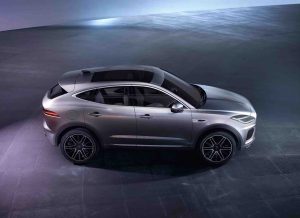
A top-of-the-line P300 – which stickers for $49,495 – is partially electrified. It also has the 2.0 liter turbo’d four under its hood but it’s paired with a mild hybrid system that keeps the internal combustion engine off as often as possible.
Interestingly, this does not save gas. The hybrid P300 rates virtually the same gas mileage as the non-hybrid P250 – 20 city/26 highway vs. 21 city/26 highway.
What you do get is more power – 296 horsepower vs. 246 for the non-hybrid’s stand-alone turbo’d four – without using more gas.
And the hybrid E-Pace emits less gas – carbon dioxide – by dint of keeping the gas-burning engine off as often as possible. This helps Jaguar remain in compliance with the regulations that are pushing gas-burning engines into oblivion.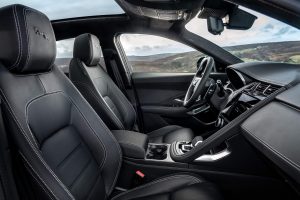
What’s new
A surround-view camera has been added to the options list and all trims now come standard with a rearview camera.
What’s Good
Electrification is still optional.
Standard AWD – for thousands less than rivals like Mercedes charge for the rear-drive versions of models like the GLC300 ($43,200)
Just being a Jaguar helps this crossover stand out from the pack.
What’s Not So Good
Electrification soon won’t be optional.
More than run-of-the-mill power/performance adds almost $10k to the price.
Rivals like the BMW X1 cost thousands less – even when equipped with their optional AWD ($37,900).
The base P250 trim comes standard with a 246 horsepower turbocharged four cylinder engine – paired with a nine speed automatic.
This is not much engine – for almost $41k to start. Much less for a Jaguar.
Especially in view of the engine you can get for just over $30k in essentially similar compact crossovers like the Mazda CX-30, which offers a slightly bigger 2.5 liter, 250 horsepower turbo’d four for $30,050.
Or the Kia Sorento EX – which comes with an even stronger 281 horsepower 2.5 liter engine for $35,990.
Of course, they aren’t Jaguars.
And this Jaguar isn’t the only $40k-plus luxury-badged compact crossover that hasn’t got much more standard engine in terms of size or horsepower than non-luxury-badged (but otherwise similar) crossovers. The Benz GLC300 is only packing 2.0 liters and 255 horsepower – for $43k. The $37k to start Lexus NX300 makes do with just 235 hp (again, out of 2.0 turbocharged liters). A $35k to start Audi Q3 gets you all of 184 horsepower – also out of 2.0 liters of four.
Still, it’s sad.
Gone are the silky inline sixes – and the spectacular/exclusive V12s – that once defined a Jaguar. And which you expected to get when you paid Jaguar money. Of course – again – the same is equally true of all the other luxury brands, which have been reduced by the regulations to installing similarly small, comparatively underpowered fours in vehicles that, in better times, would have come standard with at least a six.
The good news – as such – is that more power is available, if you’re willing to pay a lot more to get it.
The P300 version of the E-Pace is boosted by a turbo and a mild hybrid tandem powertrain, which bumps the total output 296 horsepower without bumping the fuel consumption hardly at all. There is a negligible 1 MPG difference, city-highway, between this Jag’s two available powertrains.
There is also a significant difference in terms of acceleration. With the mild-hybrid boost, the P300 version of the E-Pace can get to 60 in about 6 seconds flat while the standard P250 version needs about 6.7 seconds to make the same run.
There is also another important difference – which helps to offset the price difference. It is that that the P300 gets a more able all-wheel-drive system, with torque-vectoring. That means the system is more than front to back, as most AWD systems are. It is also side to side, which enhances traction and handling.
There is also a noteworthy similarity between the two versions of this Jaguar and a big difference – as regards the hybrid version of it – vs. many other hybrids.
Both the P250 and the P300 use a conventional (geared) nine-speed automatic transmission. Many hybridized vehicles use a continuously variable (CVT) automatic, which some buyers dislike on account of the CVT automatic’s sensation-free feel and (often) the noises they make under hard acceleration.
This Jaguar – either version – also has a fairly stout maximum tow rating (about 4,000 lbs.) for a compact-sized crossover. Many of these are rated to pull no more than 1,500-2,000 pounds.
The government hasn’t regulated suspension tuning out of existence – or homogenized it – yet.
Thus, Jaguar is still able to impart some distinctiveness in handling feel. Jaguar says the E-Pace’s chassis shares engineering details with the F-Type coupe, Jaguar’s last car. That one is also a rear-drive car, as Jaguars (and most high-end cars) always used to be. The reason being to put distance between them and the front-wheel-drive masses both in terms of the thing itself and also because the rear-drive layout almost always feels better, because it is better balanced.
Instead of the weight of the drivetrain being mostly over the front wheels, it is spread out over the length of the vehicle. This usually results in more neutral handling, less oversteer at lower speeds (in the curves) and a more pleasant-feeling inclination to oversteer (tail out) at high speed in the curves.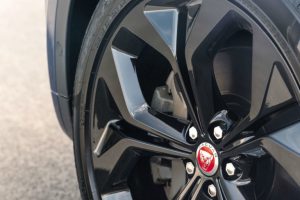
And in a rear-drive car, the wheels that steer do not also have to propel.
But the front-drive layout is more compact – and that is an important consideration when designing a compact-sized vehicle. It also serves to increase traction by having more weight over the primary drive wheels and because it is better to pull than to push when it comes to getting going in snow.
Still, this is a Jaguar – and it ought to feel like one.
 And does. Just higher up. The steering is nicely weighted for road feel and accuracy; the suspension has give without too much roll – and the tested P300 with the torque-vectoring AWD system felt as neutral in the curves as if it were rear-drive-based. Any tendency to track toward the inside of the corner while cornering is automatically corrected for by the imperceptible application of more or less engine power to the appropriate side (inner or outer wheels) although this does also tamp down the accessibility of tail-out oversteer, which will be missed by the few heretics who still practice such dark arts.
And does. Just higher up. The steering is nicely weighted for road feel and accuracy; the suspension has give without too much roll – and the tested P300 with the torque-vectoring AWD system felt as neutral in the curves as if it were rear-drive-based. Any tendency to track toward the inside of the corner while cornering is automatically corrected for by the imperceptible application of more or less engine power to the appropriate side (inner or outer wheels) although this does also tamp down the accessibility of tail-out oversteer, which will be missed by the few heretics who still practice such dark arts.
Still, the thing does a fine job of handling – and feeling – like a Jaguar. It’s just a shame about the engine, which isn’t bad as such. It’s just not very Jaguar, for those who remember what Jaguars used to sound like.
And there is also the intangible but still quantifiable disappointment of having a Jaguar that has – essentially – the same engine that practically every other crossover also has. One of the great satisfactions of owning a Jaguar – of owning a uniquely Jaguar six or twelve – has been lost.
It’s not Jaguar’s fault. But Jaguar is something less, just the same.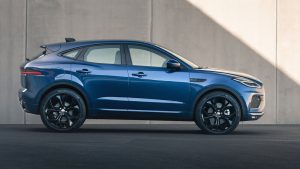
At The Curb
Styling a crossover involves two contradicting design goals.
A crossover’s basic shape is dictated by what a crossover is – which is why so many crossovers look so much the same. It is hard to change the purpose without changing the shape – which then changes the purpose. Then you have a vehicle that’s not what people shopping for crossovers want, which is lots of space and room on the inside.
This dictates the form, outside.
But people who want a Jaguar probably don’t want just another crossover that happens to have a Jaguar badge. And price.
Jaguar tries.
But there is only so much that can be done. There is a recognizably Jaguar-shaped grill, with the Jaguar door-knocker in the center and at the rear there are a pair of F-Type-like brake lights. But from the side, it’s much the same – because it pretty much has to be, in order to be what it is.
Which is a compact crossover – with much more room inside relative to its footprint (just 173 inches end to end) than a car with a much larger footprint. This smallest Jaguar has 22.4 cubic feet of storage space behind the rear seats – which is vastly more storage space than you’ll find inside the trunk of any full-sized car – and just shy of 50 cubic feet with the second row folded. 
There is also generous space for legs – in both rows. Up front. 40.6 inches and in back, almost as much (39.3 inches). All of which makes this Jaguar crossover vastly more practical than any car Jaguar still makes.
Inside the E-Pace, the look is more Jaguar. There’s the leaper in the horn button and some nicely fluid styling embellishments, including an offset center console reverse L grab handle and a fist-sized gear selector similar to the one in the F-Type coupe. An interesting departure from the typical is the soft LED climate control display – kind of a frosted glass look – just below the main LCD gauge cluster. There are also still rotary knob controls to make adjustments, too.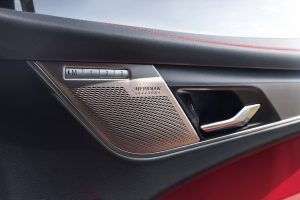
All trims – including the base P250 get leather (real leather) seating and Jaguar’s excellent Meridian audio system, comparable to the Burmester system used by Mercedes but – in this writer’s opinion – superior. Regardless, one of the things modern luxury-brand vehicles still have that the generic brands don’t (yet) is concert-quality audio systems. The generics often have very good systems – but to appreciate the distinction, you need to listen to a system such as the Meridian (or Burmester) system.
Oddly – for a luxury-brand crossover – a power rear liftgate is not standard. Ditto memory for the driver’s seat settings. That – and a fully digital main gauge cluster – are available, if you spring for the P250 SE, which stickers for $45,995.
The P300 – in addition to the stronger drivetrain and the torque-vectoring AWD upgrade – also comes with 20 inch wheels (18s are otherwise standard), adaptive suspension dampers and a heads-up (HUD) display.
Can Jaguar be Jaguar in an electrified future? What would the difference be? Especially as regards electrified crossovers, which already look more or less the same. What will sell them when they are more or less the same, functionally? An electric motor is an electric motor. There’s not much difference – beyond output (and range) – one vs. another. All the character is gone.
And without that, what is a Jaguar?
The Bottom Line
This may be your last chance to buy a Jaguar that isn’t an electrified cat. And it may be one of the last Jaguars, period.
. . .
Got a question about cars, Libertarian politics – or anything else? Click on the “ask Eric” link and send ’em in!
If you like what you’ve found here please consider supporting EPautos.
We depend on you to keep the wheels turning!
Our donate button is here.
If you prefer not to use PayPal, our mailing address is:
EPautos
721 Hummingbird Lane SE
Copper Hill, VA 24079
Also, we do accept Crypto. If you’d like to donate that way, please email EPeters952@yahoo.com for details.
PS: Get an EPautos magnet or sticker or coaster in return for a $20 or more one-time donation or a $10 or more monthly recurring donation. (Please be sure to tell us you want a magnet or sticker or coaster – and also, provide an address, so we know where to mail the thing!)
My eBook about car buying (new and used) is also available for your favorite price – free! Click here. If that fails, email me at EPeters952@yahoo.com and I will send you a copy directly!


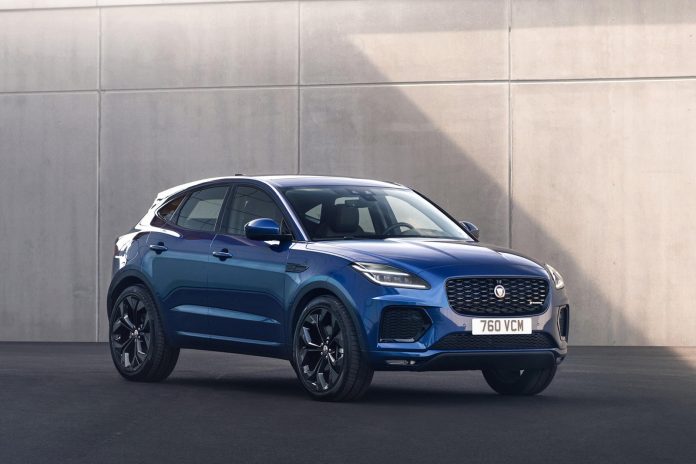

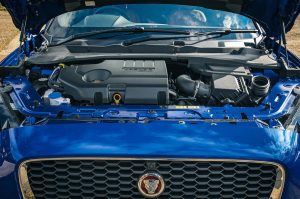










most cars will be chinese pretty soon, volvo, polestar, lotus, MG, and others already are
in this video they talk about the chinese taking over the electric car market, they are starting to export their EV’s worldwide, their EV’s are supposed to be advanced and cheap
…… in another video a lawyer says the chinese are taking over the german car manufacturers,
at this rate everyone will be driving a chinese car soon, a lot of electronics in your car made there already…….
no wonder tesla moved a lot of production to china…
the chinese make most of the chips, maybe the shortage was to help their EV launch….
they also supply all the materials used in manufacturing all/most drugs and vaccines (do you trust the quality enough to inject yourself? haha), another booming market…$$$$$$$$$$$
https://www.youtube.com/watch?v=jclSYJb8oa0
Eric, didnt know where else to rant about this – but did you see this ?
https://www.zerohedge.com/markets/tesla-help-jaguar-land-rover-meet-eu-emissions-criteria
Because of fuckery like this – the new Range Rover starts at 100K !! (remember this was once the car for the farmer who wanted something more civilised than the original 90 or 110 !)
Who’s on first what’s on second?… The “English” car Jaguar (and Land Rover) are owned by Tata Motors – an Indian company (India).
Ford owned Jaguar/Land Rover previously, resulting in some excellently styled Fords.
A German lawyer in an interview said China is taking over the German car industry, if you love German brands this might be a sad event.
German cars are overrated. We owned a Mercedes AMG 55. Beautiful car, fast, but the resale on them stink and the parts to replace anything was astronomical. I had to put a paycheck aside just for an oil change. That was the only car that left me stranded in the middle of 17 Bypass in Myrtle Beach crossing 82nd Street N. The second happiest day of my life is when we sold that car, the first was when we sold the Ford Saleen.
I don’t like any new cars, (the T50 could be OK). I like all the old stuff, after the 90’s there is too much computerized, overweight nanny state safety junk. The Germans made some great cars, the aircooled beetle was one of the best cars ever in many ways, small, light, analog, easy to wrench on, simple, bulletproof, reliable, fun, cheap, economical, sounded cool. Porsche made many great cars, (check out all the aircooled 911’s, 356’s and resale values), the first Porsche I bought was a 1973 914 2 litre, it was fun, analog, totally reliable, very strong, sounded great, economical, perfectly balanced, problem free. I owned a 1984 BMW E30, that was a fantastic, problem free, fun, balanced, very well made, very strong car. I have a 1988 Porsche 924s Le Mans, it is a very well balanced, very strong, reliable, computer free, simple, analog, a fantastic transaxle driving experience. (front engine, rear transaxle = best handling design). The old Mercedes diesels used to go one million miles. The old German cars were over engineered, now all the new cars are overweight, plastic, computerized, very complicated, expensive, nanny state junk, with a horrible isolated, computer controlled driving experience. If you want a real, direct, raw, unfiltered, analog, non nanny state, the most fun driving experience, go and test drive a Lotus super 7 or clone super 7. there is a German one the HKT….an HKT with an Audi 1.8 20vt 400 hp engine, 1300 lb. zero to 200 khm (124 mph), 7.5 seconds, crazy fast, only $80,000.
At least the British still have Dutton, the oldest car manufacturer in the world still owned by the original owner. It only manufacturers amphibious cars now, it is the only profitable amphibious car manufacturer on the planet. In 1978 it was the largest kit car manufacturer on the planet, it built 8000 Lotus super 7 replicas. Lotus only made 2500 super 7’s, the super 7 was the 2nd most copied car on the planet, 160 companies made copies of the super 7, the Cobra was number 1 most copied design. Caterham bought the rights to build the super 7, then sued all the replica makers. Sadly Caterham is Japanese owned now, the British lost that too. The super 7 is the ultimate small light analog, direct, connected, unfiltered, raw driving experience (steel tube frame, total weight 1200 lb), it is a must drive for hard core car freaks, a different driving experience, owners like the light weight and throttle response, it changes direction like nothing else. In 2003 and 2004 a super 7 clone, a Donkervoort had the lap record for street legal cars at the Nurbergring 7 min 13 sec. A Dutton super 7 clone is the quickest kit car on the planet, it weighs 1400 lb and has a 434 c.i. small block chev engine, it runs 8.90 in the 1/4 mile. super 7’s rock. I bought one 5 months ago, a very cool, unique, very fun driving experience, also very simple and easy to wrench on.
“A top-of-the-line P300 – which stickers for $49,495…..”
Let’s face it, $50K for an “entry level” luxury car just isn’t that much money. It’s not going to buy you a big engine, or any other awe inspiring hardware. All you get for that price are superficial luxuries, like Jag badges, leather seats, and upgraded sound systems. This applies to the bottom feeder priced Mercedes, Audis and Beemers too.
In terms of quality and performance, if you want a real luxury vehicle, plan on spending at least twice that price.
True, Mike –
And it’s a sad measure of the devalued times, eh? I can’t imagine how depressed I’d feel – having spent $50k – and driving a compact crossover that’s not functionally much superior to many $30k non-lux-badged offerings, as mentioned in the review. I miss real Jaguars. A lot.
Eric,
I don’t understand WHY the luxury car makers, or any car makers for that matter, HAVE to use the 2.0L engine! What regulatory sanction does a car maker get if they-gasp-make something else besides the ubiquitous 2.0L four? What penalty(ies) do they suffer? Aren’t they just hit with a “gas guzzler” tax if they don’t meet the CAFE numbers? If they get hit with the tax, can’t they just pass it on to the buyer? If someone is buying a Jag, aren’t they buying it, in part, because it HAS those sixes or twelves? under the hood? And if they’re buying a Jag because it has a Jag engine, will they have any objection to paying extra to get what they want? Isn’t that the whole POINT to luxury vehicles-exclusivity? Isn’t the point to have something not everyone can have? If someone can pay $50K or more for a vehicle, they won’t object to a few grand extra in taxes-IF they get something exclusive for those $$$…
I don’t understand why Jaguar needs SUVs/crossovers when Land Rover already has that covered. Both brands share the same showroom.
Back when I was going to church (before they bowed down to the Kentucky governor, Andy the Evil Boy-King, and closed the doors), when I arrived for the third service I usually parked near a Jag that resembled a station wagon. When they started that thing, it was like music! Hearing the rumble of that engine was wonderful.
Question: Are these crossovers and SUV vehicles the same vehicles they sell worldwide or just North America? Seems like other than the RX-300 that started it all, they really are just phoning it in with these. Sure, the interior is nice enough but it is getting more and more difficult to tell the difference between the Jag, Alpha’s Giulia and the Maserati Levante (or are the last two the same with different badges?), and none of them look like they’re worth more than a Hyundai Santa Fe. At least I can still recognize a Cayenne when I see one.
Hi RK,
Yup; for the most part… although you can still often get a diesel-powered variant in Europe. It’s depressing.
Eric – I picked up the F pace with the V6 diesel some time back, its amazing how good diesel is as an efficient fuel, while yet giving enough power to have a bit of fun… And it would be even better for American drives which tend to be longer and higher speed than what we have in Europe. But ofcourse politicians dont do what is better – they always have another agenda…. BTW I think you mean F type coupe in your article, the F pace is a bigger SUV).
Thanks for the catch, Nasir – fixed!
Too much coffee… not enough sleep…
Electric cars are bad enough. But an electric English car?
I propose that Jaguar name their electric car the Lucas.
Lucas made me laugh. When my brother and I used to rebuild MGB’s for fun and profit, we called Lucas ‘the Prince of darkness’.
Lotus is now Chinese owned, there will be one more ICE car, then all electric, the new one is 4000 lb, 2000 hp, (it needs it it is so heavy), another horrible, overweight nanny state car. . Lotus used to build small light cars, the first Lotus 7 was 800 lb.